A Study on Optimization of Noise Reduction of Powered Vehicle Seat Movement Using Brushless Direct-Current Motor
Abstract
1. Introduction
2. Simulation Model of BLDC
2.1. BLDC Motor Design Model
2.2. Analysis Model of the BLDC Motor
2.2.1. Magnetic Analysis Model of the BLDC Motor
2.2.2. Acoustic Analysis Model of the BLDC Motor
3. Results
3.1. Numerical Analysis and Verification
3.2. Design of Experiment for Optimization
3.2.1. Design Factor Selection and Fractional Design
3.2.2. Design Factor Response Surface Analysis and Optimization
3.3. Probabilistic Method
3.3.1. Tolerance Design for Current-Level Performance Prediction
3.3.2. Tolerance Design Optimization Performance Prediction
4. Conclusions
- Among the design parameters influencing the BLDC motor noise, the stator slot depth and stator tooth width were identified as effective parameters through the DoE method, and the noise decreased with a decrease in the stator slot depth or an increase in the stator tooth width.
- Because the sensitivity of the noise reduction effect indicated that the effect of the stator slot depth was dominant, control noise could be adjusted by varying the slot depth.
- In the optimization of the design parameters for motor noise reduction, the objective function to minimize the SPL, and the limiting condition of the design parameters resulted in a stator slot depth and stator tooth width of 2.39 and 9.00 mm to ensure a SPL of 23.2 dB. Thus, a noise reduction of approximately 4.9 dB is expected compared with the standard model at 3 kHz.
- For the optimization of design tolerance using the statistical analysis method, the confidence level was 99.76% at the effective quality management level of 3, and the motor noise could be managed at 23.5 dB or lower by controlling the design tolerance of the slot depth at ±0.05 mm.
Author Contributions
Funding
Institutional Review Board Statement
Informed Consent Statement
Data Availability Statement
Conflicts of Interest
References
- Karnavas, Y.L.; Topalidis, A.S.; Drakaki, M. Development and of a Low Cost μC-Based Brushless DC Motor Sensorless Controller: A Practical Analysis of Hardware and Software Aspects. Electronics 2019, 8, 1456. [Google Scholar] [CrossRef]
- Mohanraj, D.; Aruldavid, R.; Verma, R.; Sathyasekar, K.; Barnawi, A.B.; Chokkalingam, B.; Mihet-Popa, L. A review of BLDC Motor: State of Art, advanced control techniques, and applications. IEEE Access 2022, 10, 54833–54869. [Google Scholar] [CrossRef]
- Sikora, A.; Zielonka, A.; Woźniak, M. Minimization of energy losses in the BLDC motor for improved control and power supply of the system under static load. Sensors 2022, 22, 1058. [Google Scholar] [CrossRef]
- Kwon, J.Y.; Ju, D.Y. Analysis and classification of in-vehicle activity based on literature study for interior design of fully autonomous vehicle. J. HCI Soc. Korea 2018, 13, 5–20. [Google Scholar] [CrossRef]
- Park, H.; Lee, C. Machine-learning based smart seat for correction of driver’s posture while driving. J. Kora Soc. Digit. Ind. Inf. Manag. 2017, 13, 81–90. [Google Scholar]
- Kwon, J.-H.; Kim, K.-S.; Lee, C.-M.; Hwang, S.-M. Effect of the number of slots on the acoustic noise from BLDC motors. Trans. KSNVE 2009, 19, 759–763. [Google Scholar]
- Jeong, T.-S.; Cho, G.-W.; Kim, G.-T. The design of radial magnetic force equilibrium for reduction of vibration and noise in IPM type BLDC motor. Trans. KIEE 2013, 62, 1535–1540. [Google Scholar] [CrossRef]
- Lukaniszyn, M.; Jagiela, M.; Wrobel, R. Optimization of permanent magnet shape for minimum cogging torque using a genetic algorithm. IEEE Trans. Magn. 2004, 40, 1228–1231. [Google Scholar] [CrossRef]
- Bianchi, N.; Bolognani, S. Design techniques for reducing the cogging torque in surface-mounted PM motors. IEEE Trans. Ind. Appl. 2002, 38, 1259–1265. [Google Scholar] [CrossRef]
- Pellegrino, G.; Cupertino, F. FEA-based multi-objective optimization of IPM motor design including rotor losses. In Proceedings of the 2010 IEEE Energy Conversion Congress and Exposition, Atlanta, GA, USA, 12–16 September 2010; pp. 3659–3666. [Google Scholar]
- Tao, S.; Lee, G.H.; Hong, J.P. A drive strategy for vibration suppression in permanent magnet Brushless DC motor. In Proceedings of the 17th ICEM, Rodos, Greece, 3–6 July 2016; pp. 1–5. [Google Scholar]
- Lee, H.J.; Chung, S.U.; Hwang, S.M. Noise source identification of a BLDC motor. J. Mech. Sci. Technol. 2008, 22, 708–713. [Google Scholar] [CrossRef]
- Cho, I.-H.; Lee, N.-H.; Chang, S.-W.; An, S.-W.; Yonn, Y.-H.; Zoh, K.-D. Analysis of characteristics and optimization of photo-degradation condition of reactive orange 16 using a Box-Behnken method. J. Korean Soc. Environ. Eng. 2006, 28, 917–925. [Google Scholar]
- Fisher, R.A. Design of experiments. Br. Med. J. 1936, 3923, 554. [Google Scholar] [CrossRef]
- Box, G.E.P.; Wilson, K.B. On the experimental attainment of optimum conditions. J. R. Stat. Soc. 1951, 13, 270–310. [Google Scholar] [CrossRef]
- Kristensen, J.B.; Mu, H. Process optimization using response surface design and pilot plant production of dietary diacylglycerols by lipase-catalyzed glycerolysis. J. Agric. Food Chem. 2005, 53, 7059–7066. [Google Scholar] [CrossRef]
- Jeon, K.-W.; Choi, G.-S.; Hahn, S.-C. Optimum design for three-phase induction motor using response surface methodology & finite element method. Korean Inst. Electr. Eng. 2010, 7, 14–16. [Google Scholar]
- Letsinger, J.D.; Myers, R.H.; Lentner, M. Response surface methods for bi-randomization structures. J. Qual. Technol. 1996, 28, 381–394. [Google Scholar] [CrossRef]
- Mohamed, O.A.; Masood, S.H.; Bhowmik, J.L. Mathematical modeling and FDM process parameters optimization using response surface methodology based on Q-optimal design. Appl. Math. Model. 2016, 40, 10052–10073. [Google Scholar] [CrossRef]
- Kamal, I.M.; Binns, J.; Bose, N.; Thomas, G. Reliability assessment of ship powering performance extrapolations using Monte Carlo methods. In Proceedings of the Third International Symposium on Marine Propulsor, Tasmaia, Australia, 9–13 May 2013. [Google Scholar]
- Park, J.K.; Kang, S.S.; Yang, S.W.; Heo, Y.J.; Kim, K.T. The study on scattered radiation effects according to acquisition of X-ray imaging using Monte Carlo simulation. J. Korean Soc. Radiol. 2018, 12, 549–555. [Google Scholar]
- Coraddu, A.; Figari, M.; Savio, S. Numerical investigation on ship energy efficiency by Monte Carlo simulation. Proc. Inst. Mech. Eng. M 2014, 228, 220–234. [Google Scholar] [CrossRef]
- Browne, C.B.; Powley, E.; Whitehouse, D.; Lucas, S.M.; Cowling, P.I.; Rohlfshagen, P.; Tavener, S.; Perez, D.; Samothrakis, S.; Colton, S. A survey of monte carlo tree search methods. IEEE Trans. Comput. Intell. AI Games 2012, 4, 1–43. [Google Scholar] [CrossRef]
- Kyoun, K.Y. A study of design on the surface mounted permanent magnet type BLDC Motor for a Ventilation Jet-Fan. J. Korean Magn. Soc. 2018, 28, 53–57. [Google Scholar]
- Rasmussen, K.F.; Davies, J.H.; Miller, T.J.E.; McGelp, M.I.; Olaru, M. Analytical and numerical computation of air-gap magnetic fields in brushless motors with surface permanent magnets. IEEE Trans. Ind. Appl. 2000, 36, 1547–1554. [Google Scholar]
- Kumar, A.; Gandhi, R.; Wilson, R.; Roy, R. Analysis of permanent magnet BLDC motor design with different slot type. In Proceedings of the 2020 IEEE International Conference on PESGRE, Cochin, India, 2–4 January 2020; pp. 1–6. [Google Scholar]
- Basu, S.; Rani, S.L. Generalized acoustic Helmholtz equation and its boundary conditions in a quasi 1-D duct with arbitrary mean properties and mean flow. J. Sound Vib. 2021, 512, 116377. [Google Scholar] [CrossRef]
- Rajagopal, A.; Mandal, D.; Saiki, J.; Patnalk, U. Exterior Acoustics Using Infinite Elements. SAE Technical Paper 2019-01-1508. Available online: https://www.sae.org/publications/technical-papers/content/2019-01-1508/ (accessed on 24 January 2023).
- Li, T.; Wang, M.; He, Y.; Wang, N.; Yang, J.; Ding, R.; Zhao, K. Vehicle engine noise cancellation based on a multi-channel fractional-order active noise control algorithm. Machines 2022, 10, 670. [Google Scholar] [CrossRef]
- Yu, H.; Zhang, X.; Zhang, C. Optimization Method of the Car Seat Rail Abnormal Noise Problem Based on the Finite Element Method. Shock Vib. 2017, 2017, 4132092. [Google Scholar] [CrossRef]
- Statisti, U.; Tehnike, N. Improving the process capability of a turning operation by the application of statistical techniques. Mater. Technol. 2009, 43, 55–59. [Google Scholar]
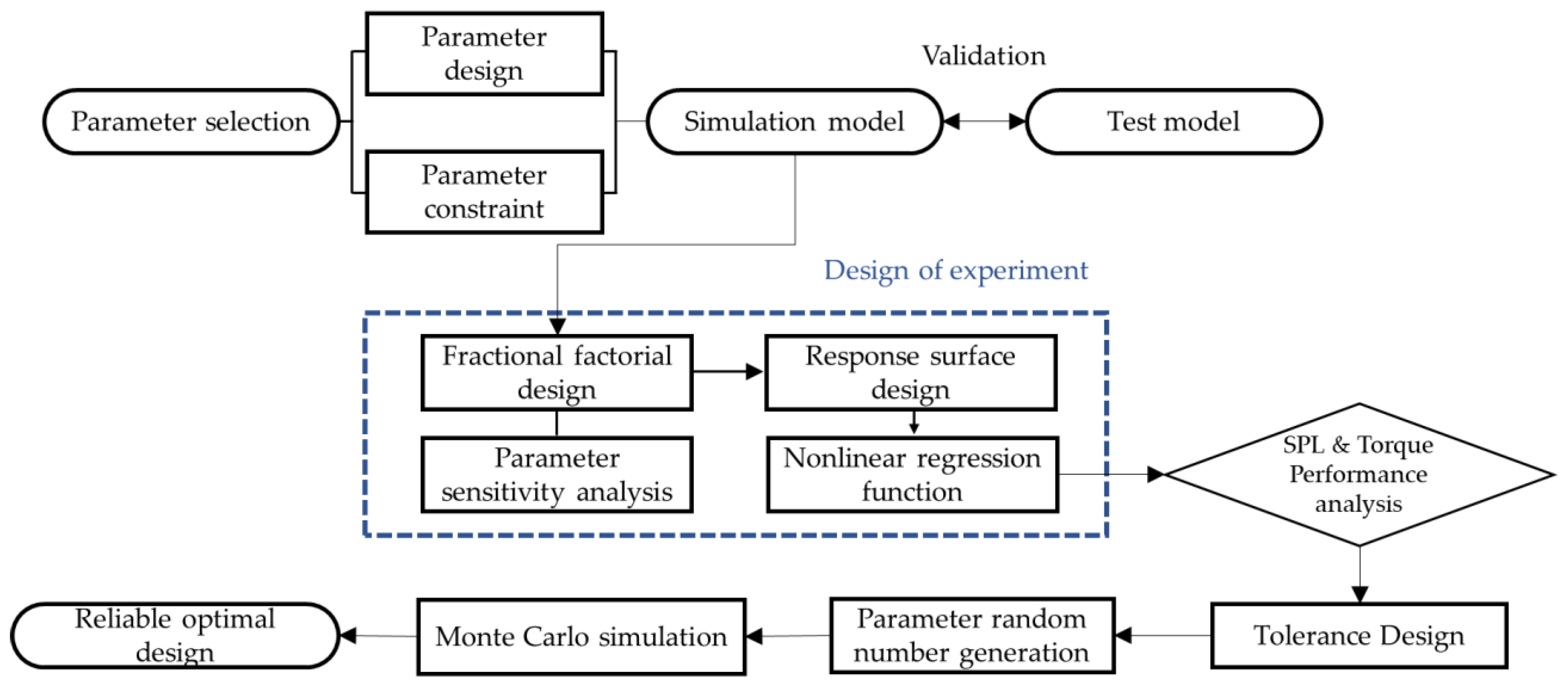
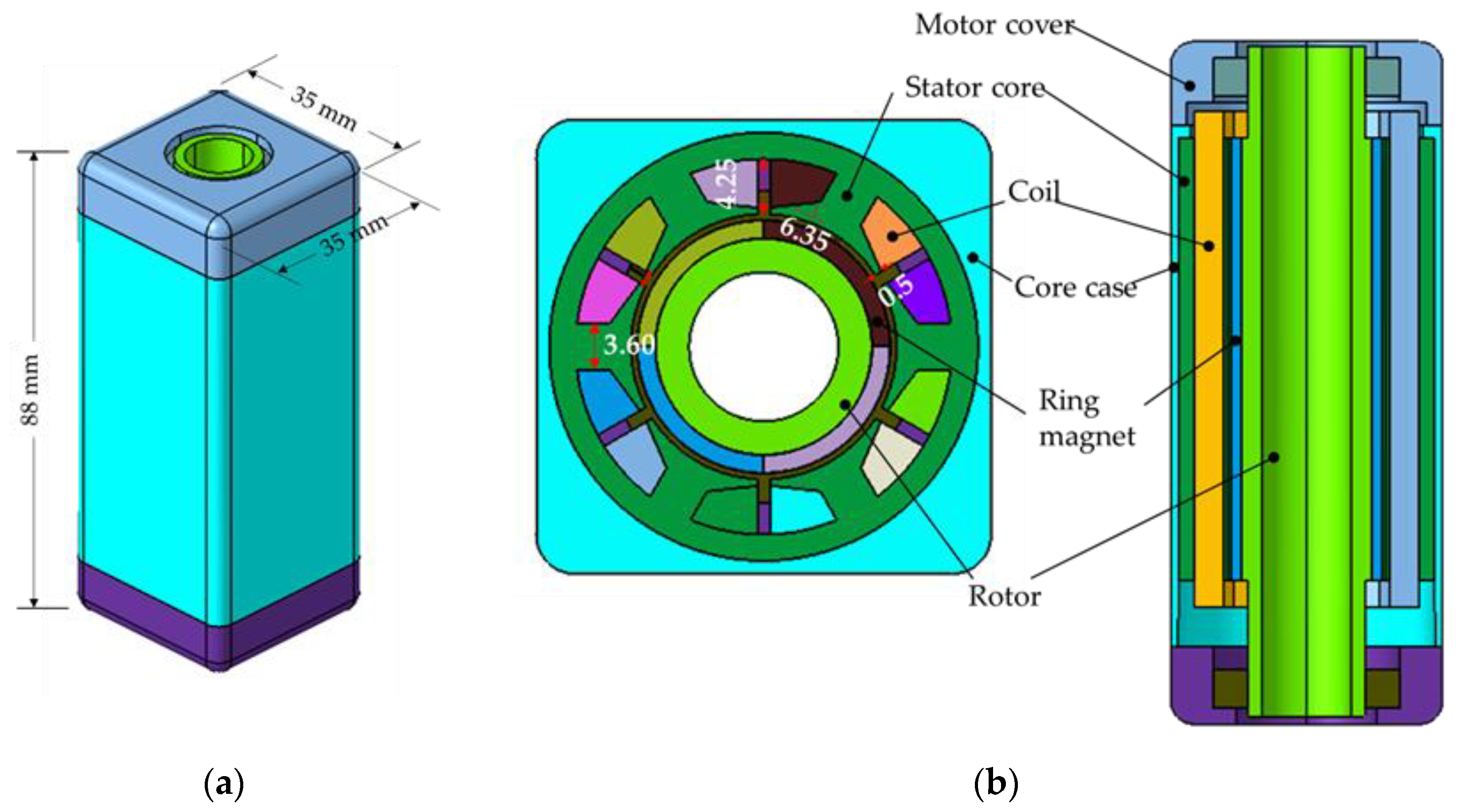
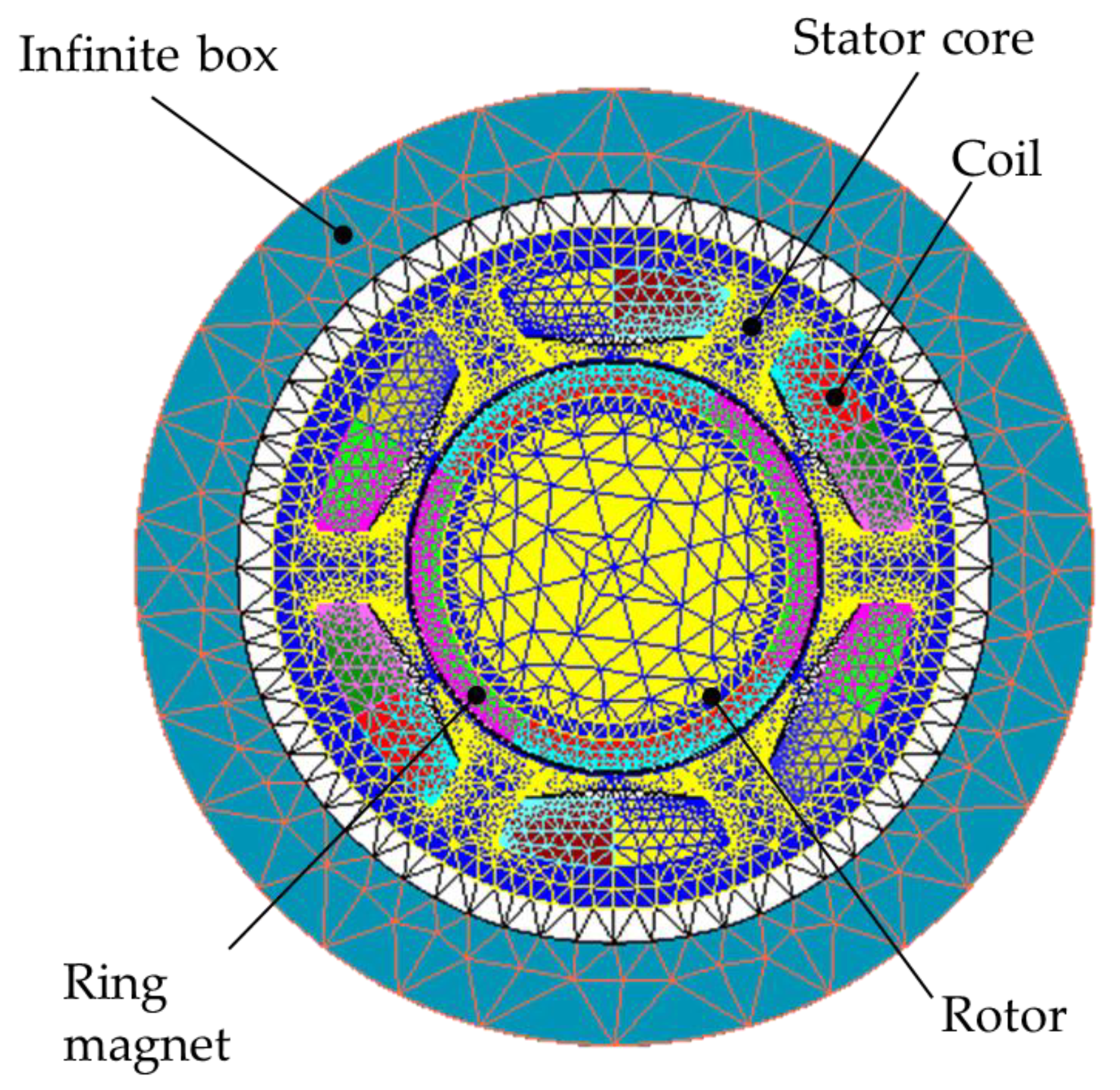
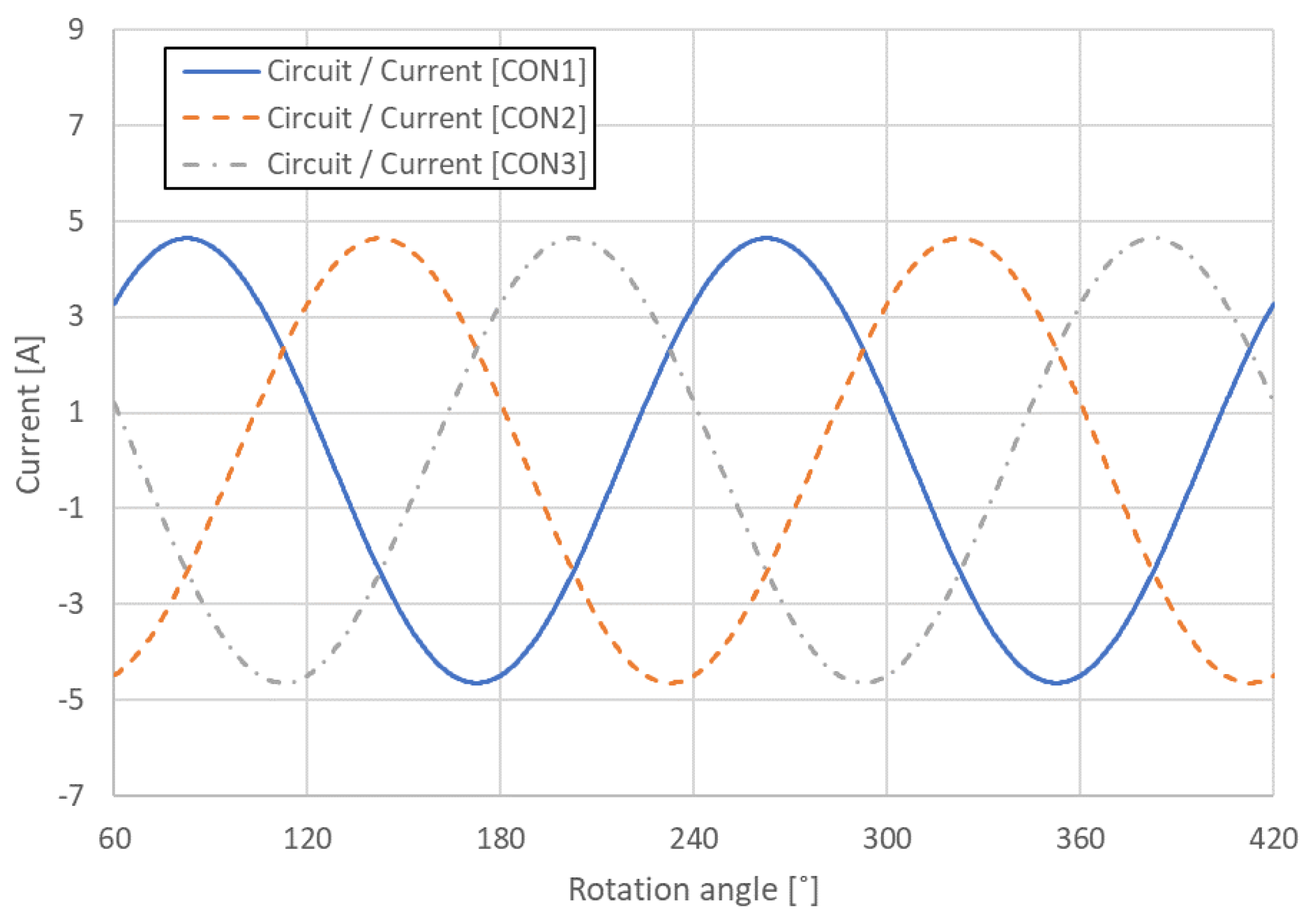
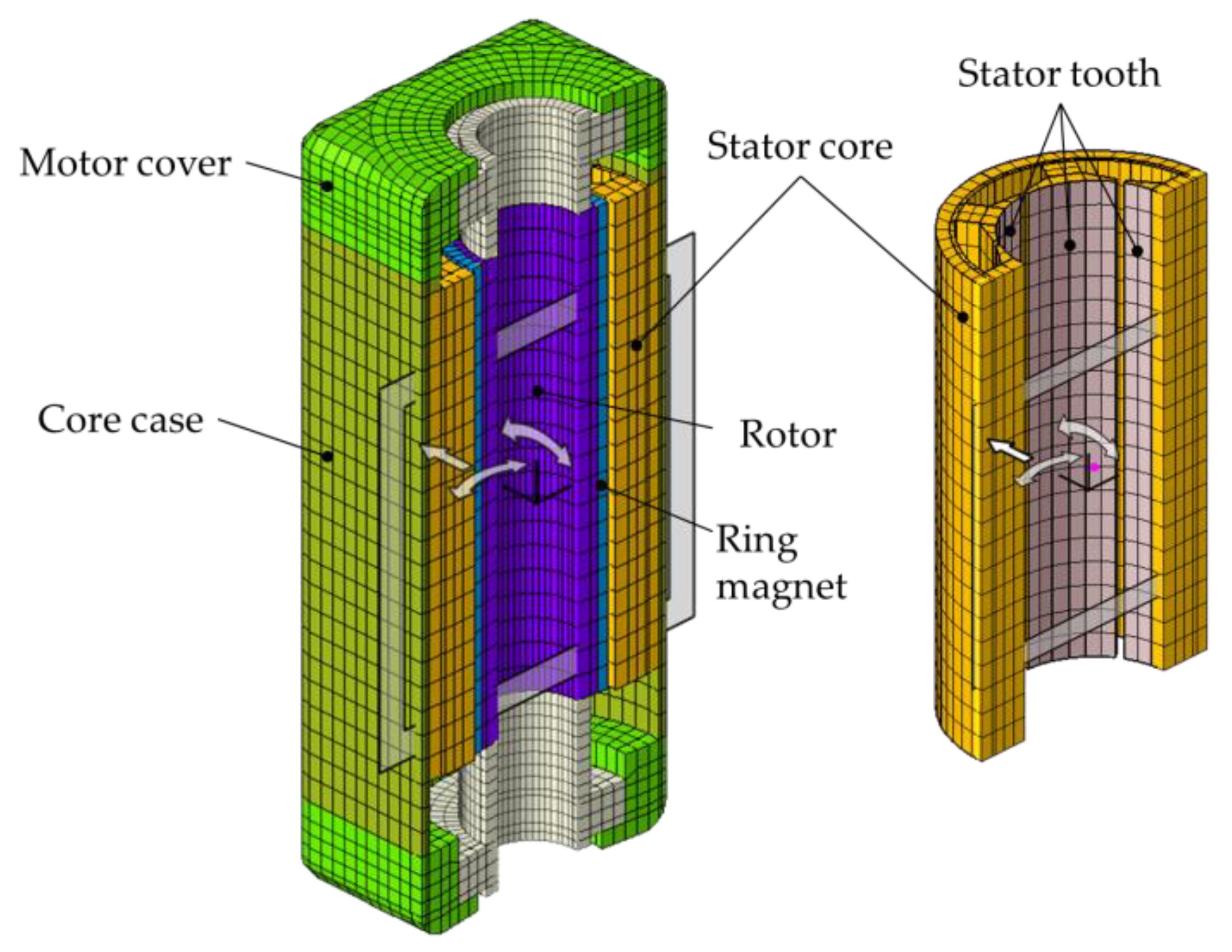
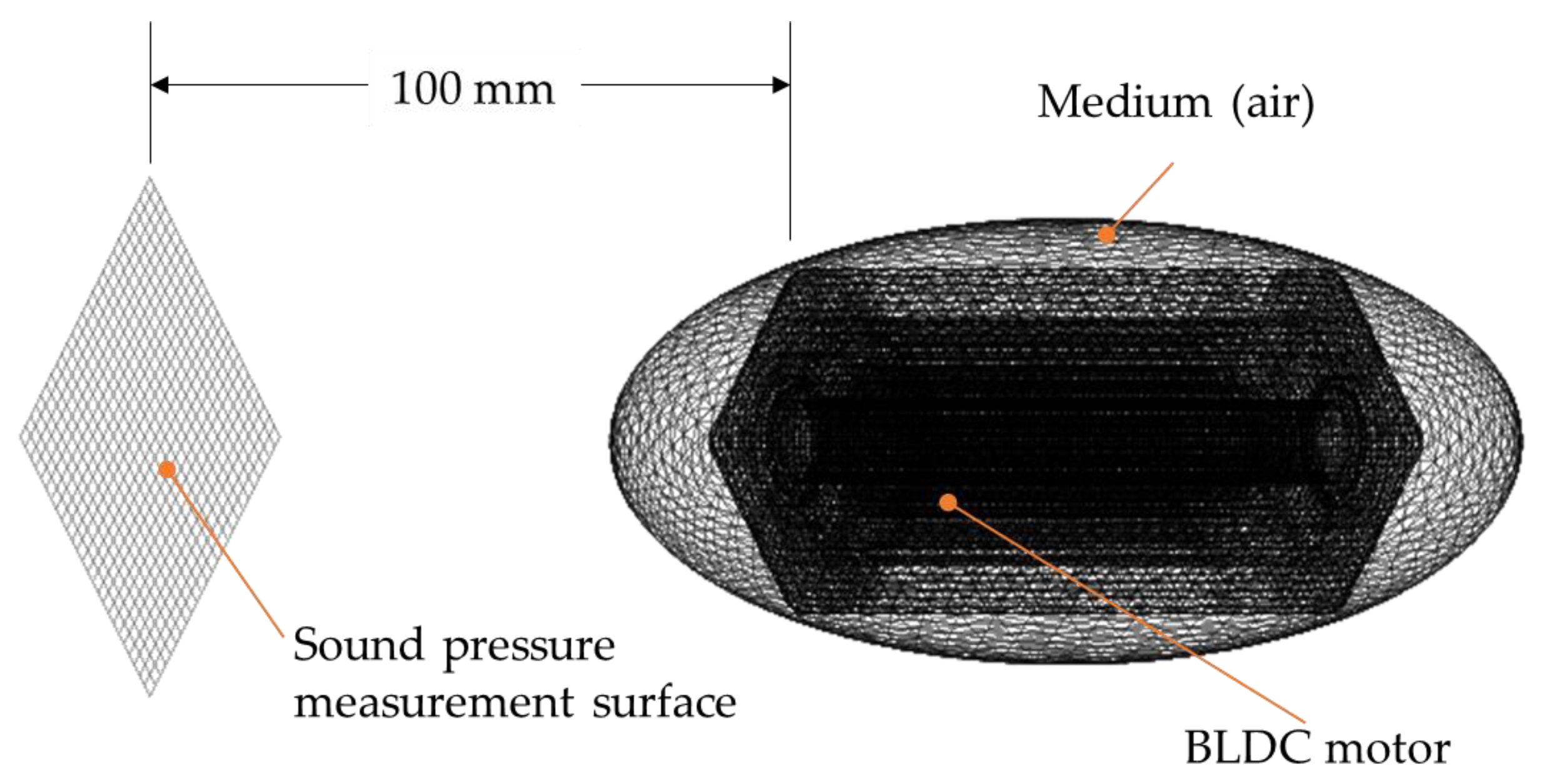
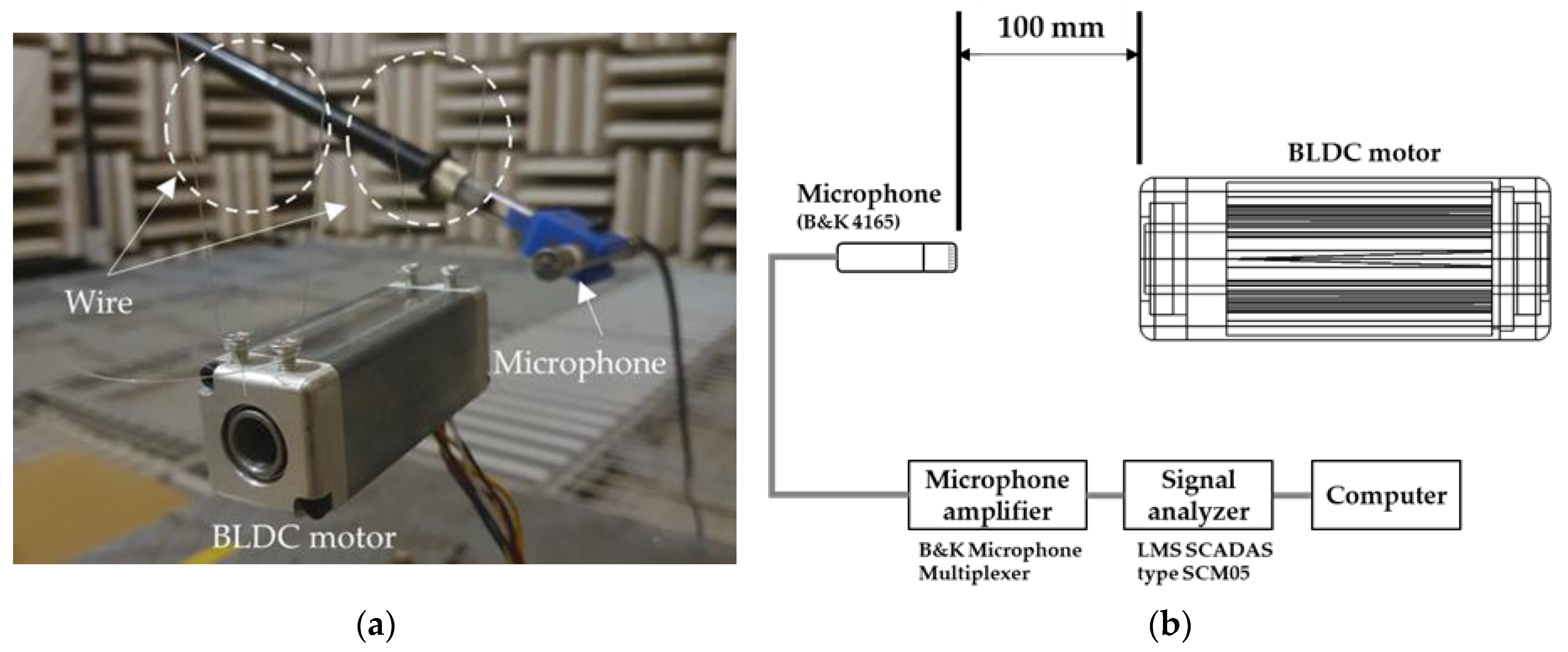

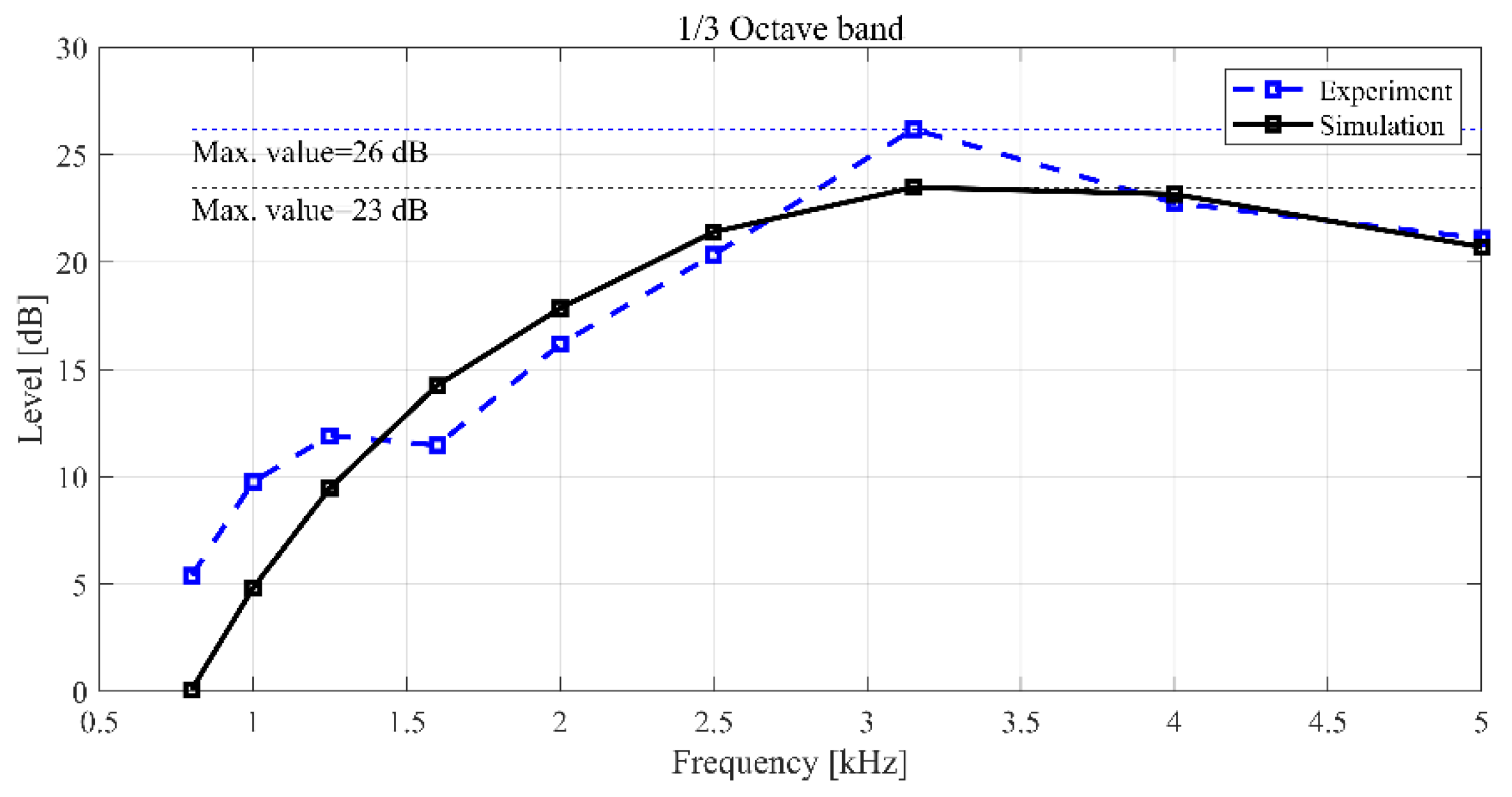

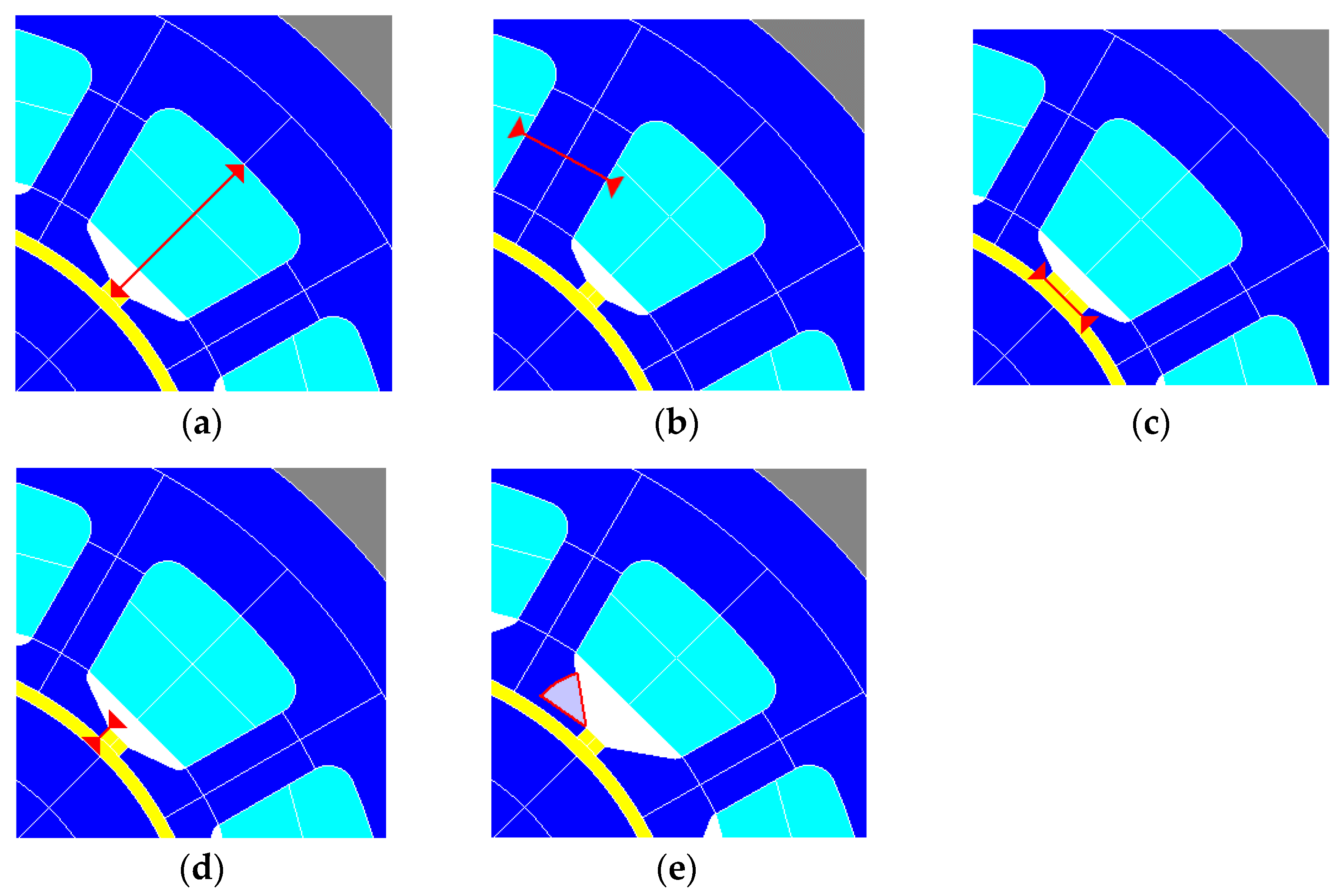
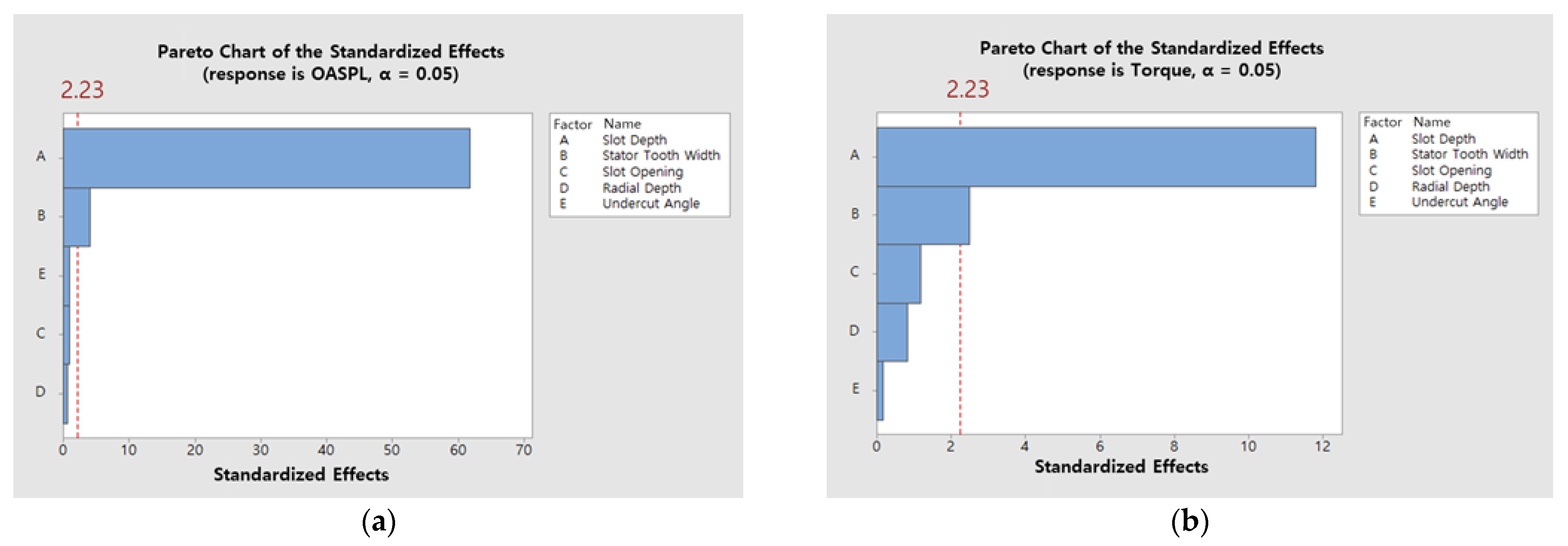
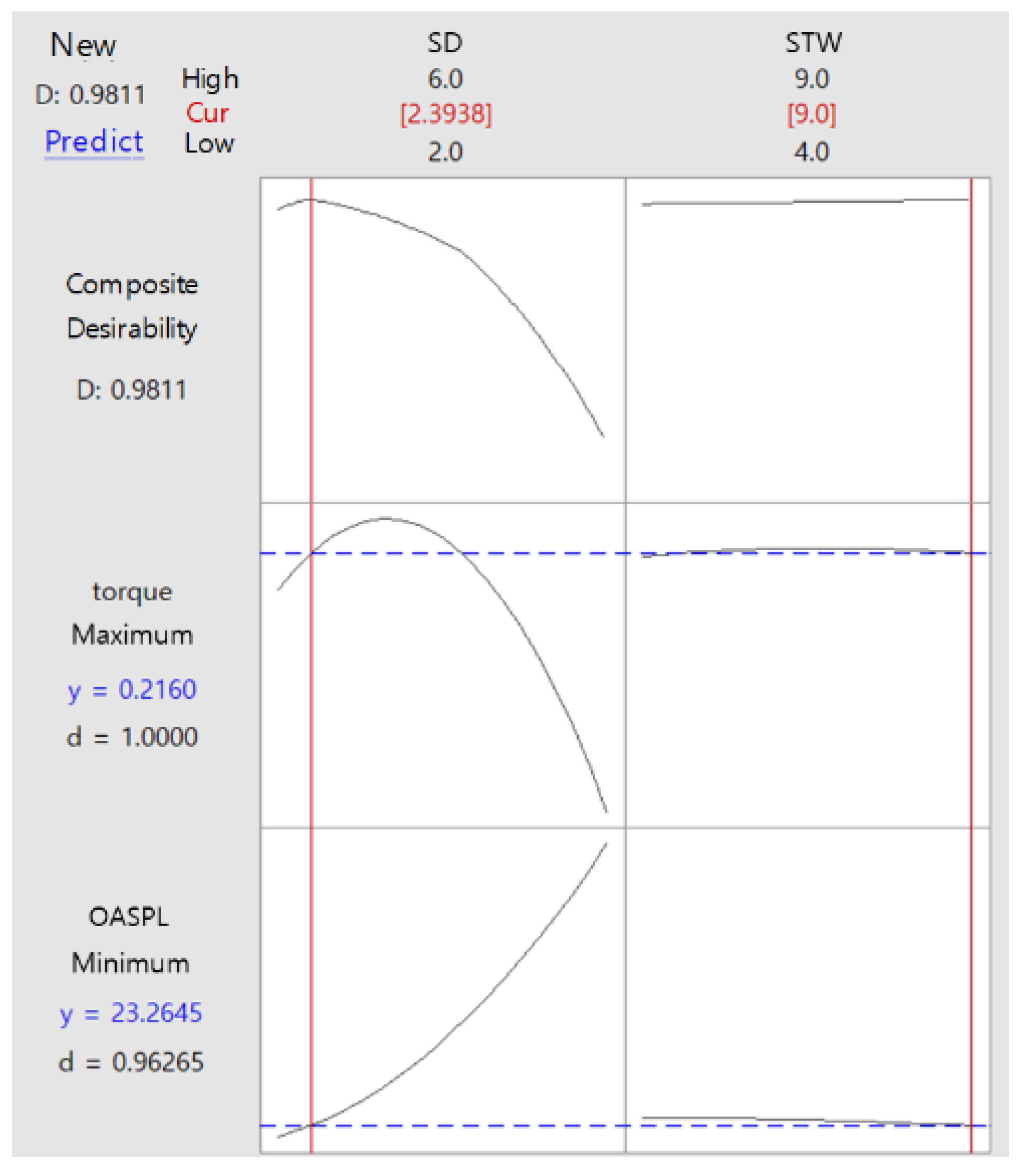
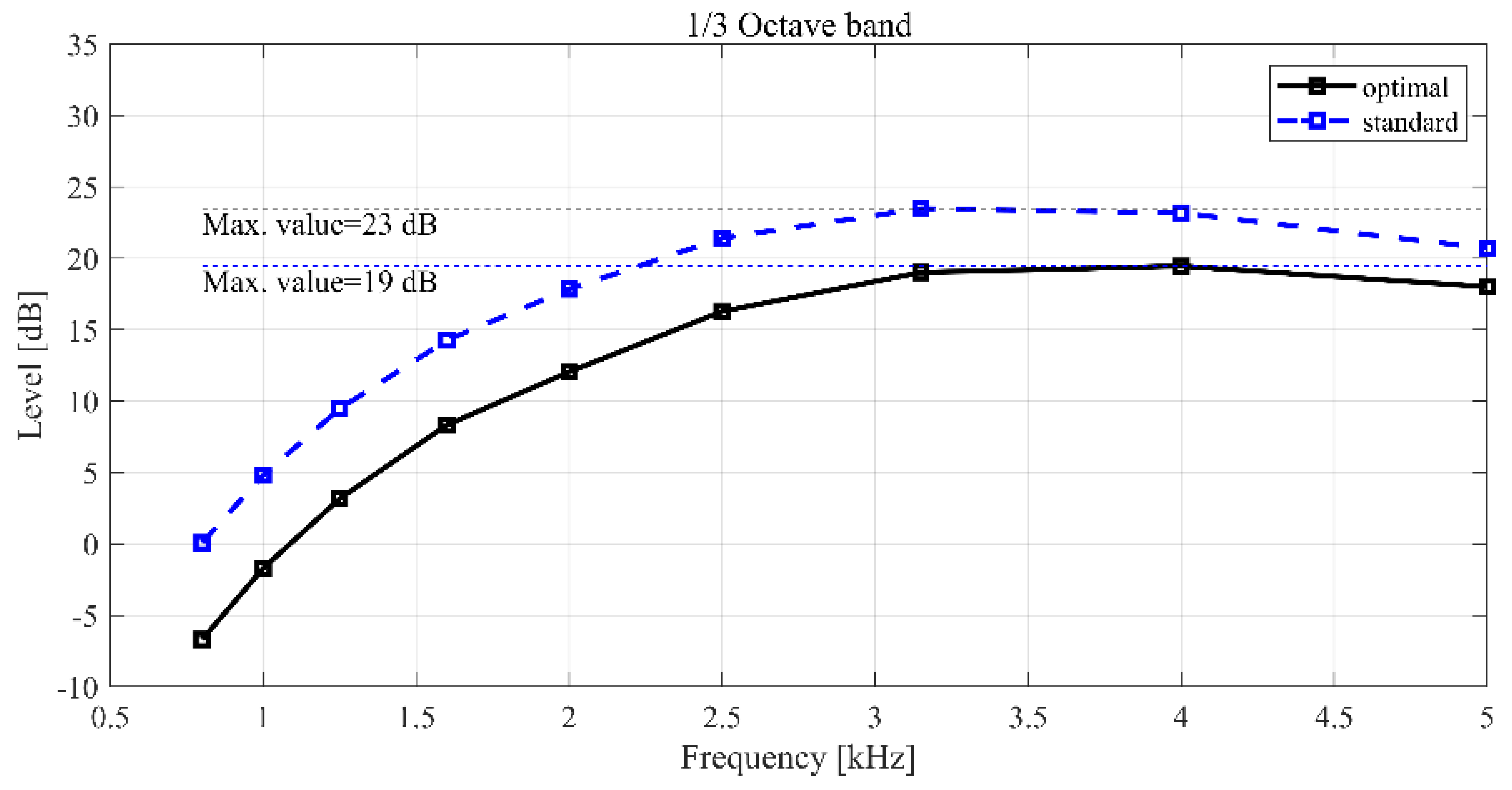

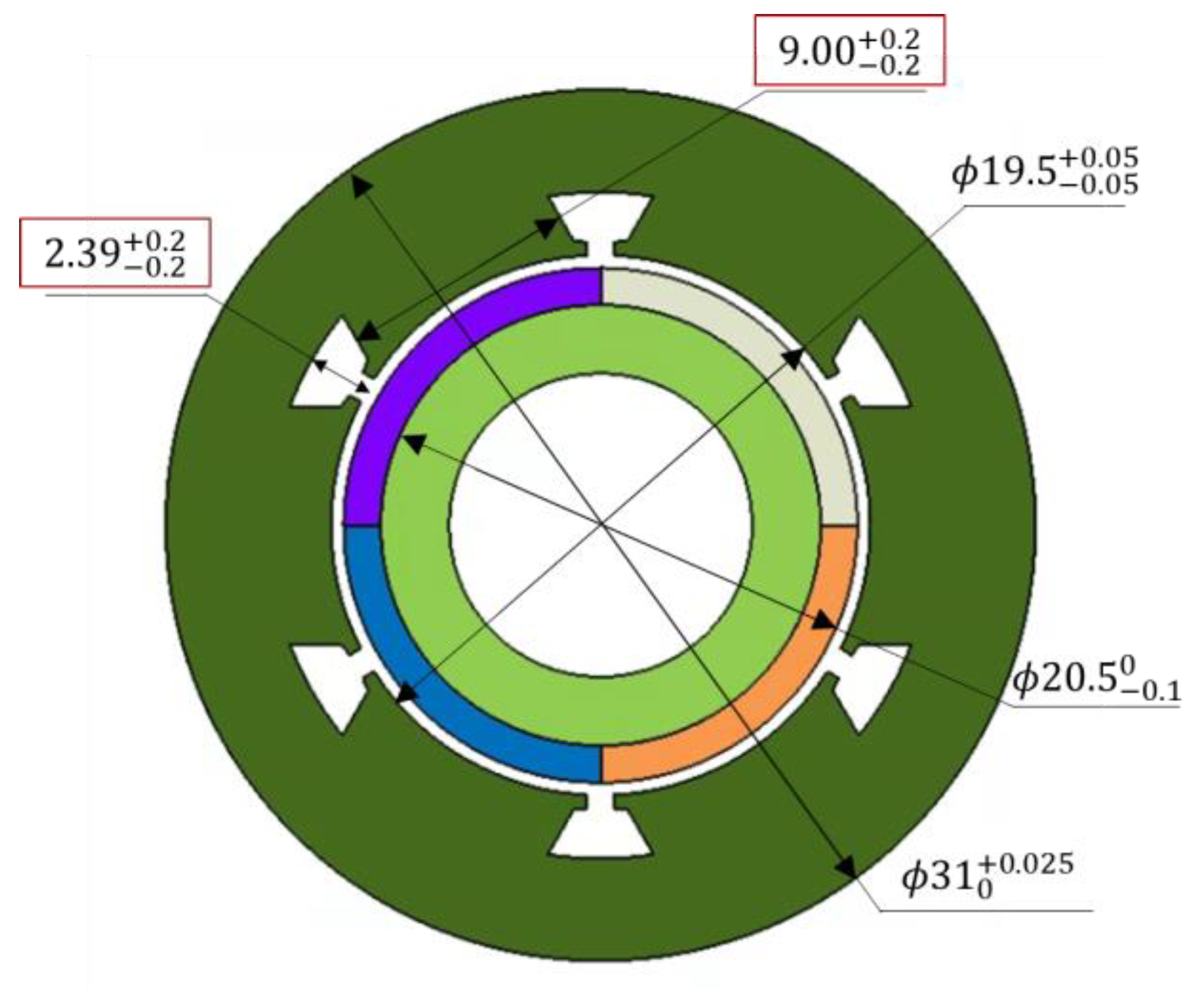
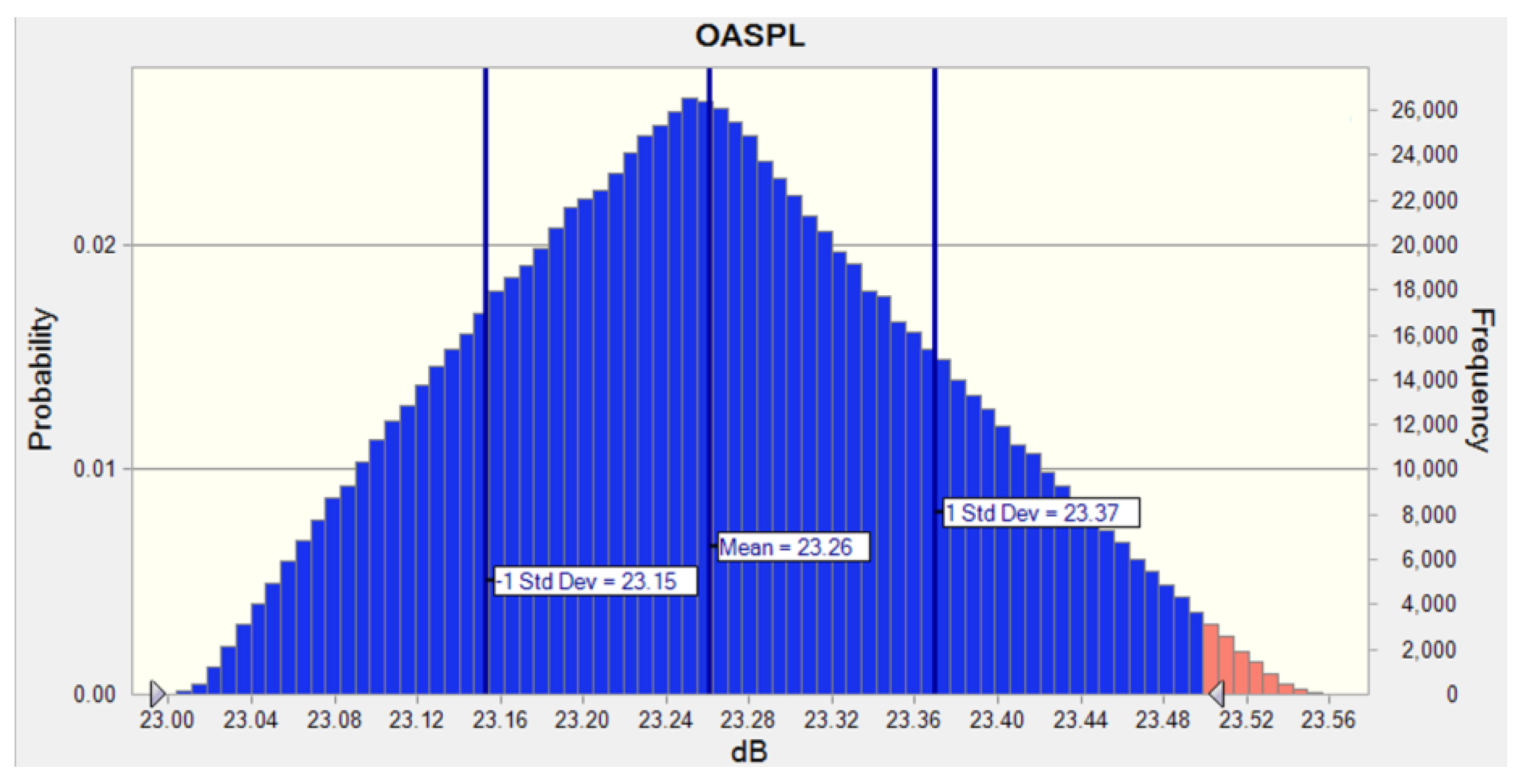
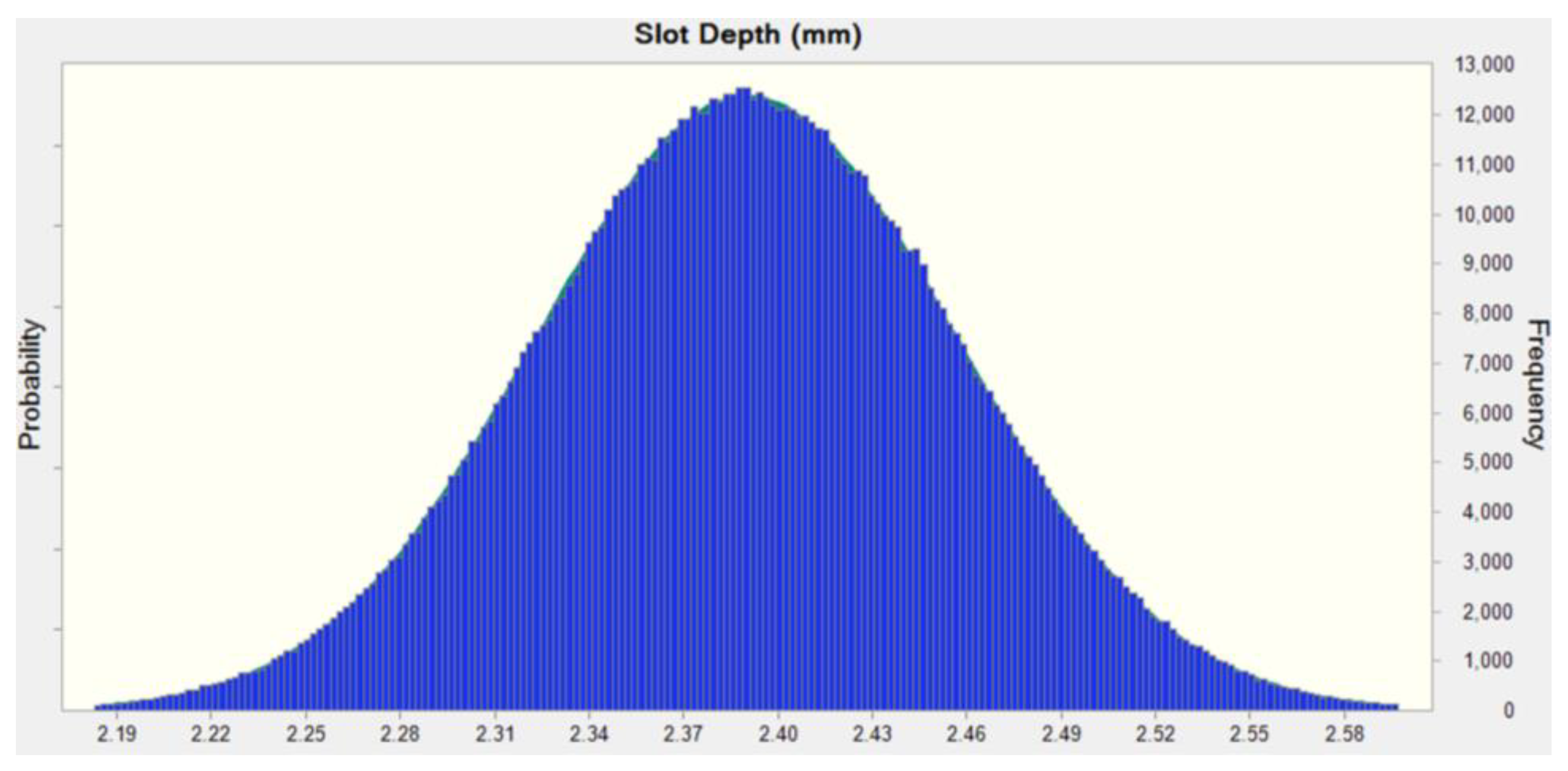
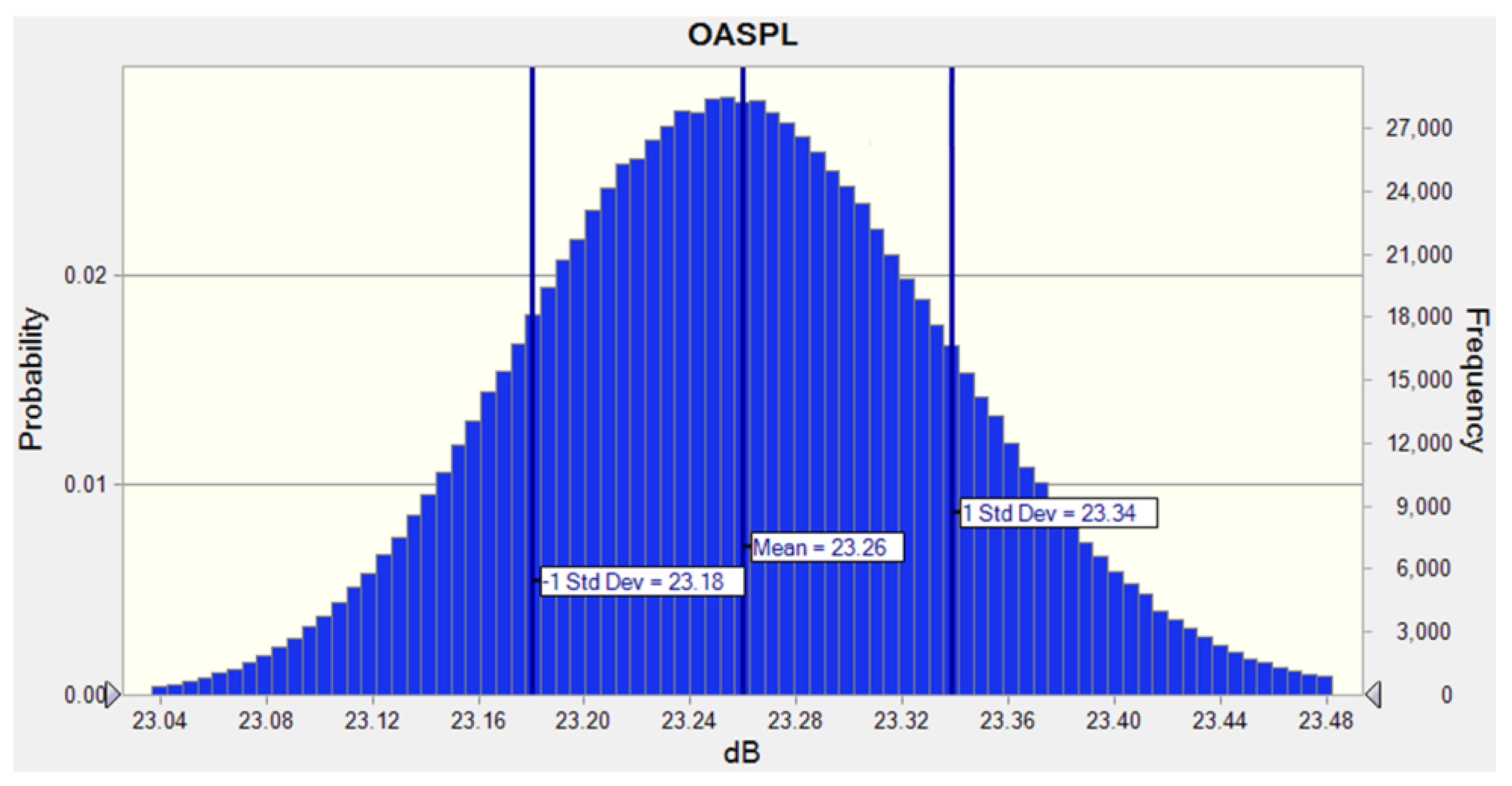
| Parameter | Value |
|---|---|
| Input voltage | 13.5 V |
| Connection | 3-phase |
| Number of poles/slots | 4/6 |
| Resistance of phase coil | 0.209 Ω |
| Number of turns | 15 |
| Diameter of stator core | 33 mm |
| Diameter of rotor core | 16.7 mm |
| Material | Density [kg/m3] | Young’s Modulus [GPa] | Poisson’s Ratio | Relative Permeability | Remanent Flux Density [T] | |
|---|---|---|---|---|---|---|
| Core case | ZAMAK 2 | 6600 | 87 | 0.27 | ||
| Motor cover | AL6061 | 2700 | 68.9 | 0.33 | ||
| Stator | 50PN470 | 7700 | 201 | 0.3 | 3980 | |
| Rotor | S20C | 7870 | 186 | 0.29 | 1085 | |
| Ring magnet | NdFeB | 7600 | 150 | 0.24 | 1.05 | 1.31 |
| Factor | Result | ||||||
|---|---|---|---|---|---|---|---|
| Slot Depth [mm] | Stator Tooth Width [mm] | Slot Opening [mm] | Radial Depth [mm] | Undercut Angle [°] | OASPL [dB] | Torque [N∙m] | |
| Standard model | 4.25 | 3.60 | 1 | 0.5 | 6.35 | 28.18 | 0.215 |
| Case1 | 6 | 5 | 0.5 | 0.75 | 3 | 35.23 | 0.205 |
| Case2 | 4 | 2 | 1.5 | 0.25 | 3 | 25.96 | 0.212 |
| Case3 | 6 | 5 | 1.5 | 0.25 | 3 | 35.18 | 0.207 |
| Case4 | 6 | 2 | 0.5 | 0.75 | 9 | 35.73 | 0.202 |
| Case5 | 4 | 5 | 0.5 | 0.75 | 9 | 25.82 | 0.216 |
| Case6 | 6 | 5 | 0.5 | 0.25 | 9 | 35.14 | 0.208 |
| Case7 | 6 | 2 | 1.5 | 0.25 | 9 | 35.73 | 0.205 |
| Case8 | 4 | 5 | 0.5 | 0.25 | 3 | 25.70 | 0.216 |
| Case9 | 6 | 2 | 0.5 | 0.25 | 3 | 35.69 | 0.205 |
| Case10 | 4 | 2 | 0.5 | 0.75 | 3 | 26.06 | 0.215 |
| Case11 | 4 | 5 | 1.5 | 0.75 | 3 | 25.70 | 0.214 |
| Case12 | 4 | 2 | 1.5 | 0.75 | 9 | 26.09 | 0.213 |
| Case13 | 6 | 5 | 1.5 | 0.75 | 9 | 35.19 | 0.207 |
| Case14 | 4 | 5 | 1.5 | 0.25 | 9 | 25.75 | 0.213 |
| Case15 | 6 | 2 | 1.5 | 0.75 | 3 | 35.77 | 0.204 |
| Case16 | 4 | 2 | 0.5 | 0.25 | 9 | 26.13 | 0.215 |
| Source | DF | Adj SS | Adj MS | F-Value | p-Value |
|---|---|---|---|---|---|
| Model | 5 | 337.803 | 67.561 | 766.52 | 0.000 |
| Linear | 5 | 337.803 | 67.561 | 766.52 | 0.000 |
| SD | 1 | 336.172 | 336.172 | 3814.07 | 0.000 |
| STW | 1 | 1.440 | 1.440 | 16.34 | 0.002 |
| SO | 1 | 0.065 | 0.065 | 0.74 | 0.410 |
| RD | 1 | 0.042 | 0.042 | 0.48 | 0.506 |
| UA | 1 | 0.084 | 0.084 | 0.95 | 0.352 |
| Error | 10 | 0.881 | 0.088 | ||
| Total | 15 | 338.685 |
| Source | DF | Adj SS | Adj MS | F-Value | p-Value |
|---|---|---|---|---|---|
| Model | 5 | 0.000334 | 0.000067 | 29.51 | 0.000 |
| Linear | 5 | 0.000334 | 0.000067 | 29.51 | 0.000 |
| SD | 1 | 0.000315 | 0.000315 | 139.25 | 0.000 |
| STW | 1 | 0.000014 | 0.000014 | 6.22 | 0.032 |
| SO | 1 | 0.000003 | 0.000003 | 1.35 | 0.272 |
| RD | 1 | 0.000002 | 0.000002 | 0.69 | 0.425 |
| UA | 1 | 0.000000 | 0.000000 | 0.03 | 0.871 |
| Error | 10 | 0.000023 | 0.000002 | ||
| Total | 15 | 0.000356 |
| Factor | Result | |||
|---|---|---|---|---|
| Slot Depth [mm] | Stator Tooth Width [mm] | OASPL [dB] | Torque [N∙m] | |
| Case1 | 4.00 | 6.50 | 27.21 | 0.216 |
| Case2 | 6.00 | 6.50 | 36.01 | 0.209 |
| Case3 | 4.00 | 9.00 | 26.81 | 0.216 |
| Case4 | 5.41 | 8.27 | 31.90 | 0.214 |
| Case5 | 4.00 | 6.50 | 27.28 | 0.216 |
| Case6 | 4.00 | 6.50 | 27.28 | 0.216 |
| Case7 | 2.59 | 4.73 | 24.06 | 0.216 |
| Case8 | 2.59 | 8.27 | 23.74 | 0.216 |
| Case9 | 4.00 | 4.00 | 27.73 | 0.215 |
| Case10 | 5.41 | 4.73 | 33.02 | 0.213 |
| Case11 | 4.00 | 6.50 | 27.28 | 0.216 |
| Case12 | 2.00 | 6.50 | 22.77 | 0.216 |
| Case13 | 4.00 | 6.50 | 27.28 | 0.216 |
| Source | DF | Adj SS | Adj MS | F-Value | p-Value |
|---|---|---|---|---|---|
| Model | 5 | 169.204 | 33.841 | 635.07 | 0.000 |
| Linear | 2 | 161.540 | 80.770 | 1515.75 | 0.000 |
| SD | 1 | 160.601 | 160.601 | 3013.88 | 0.000 |
| STW | 1 | 0.939 | 0.939 | 17.63 | 0.004 |
| Square | 2 | 7.504 | 3.752 | 70.41 | 0.000 |
| SD ∗ SD | 1 | 7.302 | 7.302 | 137.02 | 0.000 |
| STW ∗ STW | 1 | 0.009 | 0.009 | 0.16 | 0.697 |
| Interaction | 1 | 0.160 | 0.160 | 3.00 | 0.127 |
| SD ∗ STW | 1 | 0.160 | 0.160 | 3.00 | 0.127 |
| Error | 7 | 0.373 | 0.053 | ||
| Total | 12 | 169.577 |
| Source | DF | Adj SS | Adj MS | F-Value | p-Value |
|---|---|---|---|---|---|
| Model | 5 | 0.000046 | 0.000009 | 15.48 | 0.001 |
| Linear | 2 | 0.000028 | 0.000014 | 24.03 | 0.001 |
| SD | 1 | 0.000028 | 0.000028 | 46.84 | 0.000 |
| STW | 1 | 0.000001 | 0.000001 | 1.23 | 0.304 |
| Square | 2 | 0.000017 | 0.000009 | 14.45 | 0.003 |
| SD ∗ SD | 1 | 0.000017 | 0.000017 | 28.67 | 0.001 |
| STW ∗ STW | 1 | 0.000000 | 0.000000 | 0.05 | 0.837 |
| Interaction | 1 | 0.000000 | 0.000000 | 0.42 | 0.537 |
| SD ∗ STW | 1 | 0.000000 | 0.000000 | 0.42 | 0.537 |
| Error | 7 | 0.000004 | 0.000001 | ||
| Total | 12 | 0.000050 |
| Factor | Result | |||
|---|---|---|---|---|
| Slot Depth [mm] | Stator Tooth Width [mm] | OASPL [dB] | Torque [N∙m] | |
| Standard model | 4.25 | 3.60 | 28.18 | 0.215 |
| Optimal model (DoE) | 2.39 | 9.00 | 23.26 | 0.216 |
| Optimal model (Simulation) | 2.39 | 9.00 | 23.22 | 0.215 |
| Estimation of the Process | |
|---|---|
| < 1 | Not adequate |
| < 1.33 | Adequate |
| ≥ 1.33 | Satisfactory enough |
| ≥ 1.66 | Very satisfactory |
| Design Parameter | Mean | Standard Deviation |
|---|---|---|
| Slot Depth | 2.39 | 0.067 |
Disclaimer/Publisher’s Note: The statements, opinions and data contained in all publications are solely those of the individual author(s) and contributor(s) and not of MDPI and/or the editor(s). MDPI and/or the editor(s) disclaim responsibility for any injury to people or property resulting from any ideas, methods, instructions or products referred to in the content. |
© 2023 by the authors. Licensee MDPI, Basel, Switzerland. This article is an open access article distributed under the terms and conditions of the Creative Commons Attribution (CC BY) license (https://creativecommons.org/licenses/by/4.0/).
Share and Cite
Lee, H.; Ko, D.; Nam, J. A Study on Optimization of Noise Reduction of Powered Vehicle Seat Movement Using Brushless Direct-Current Motor. Sensors 2023, 23, 2483. https://doi.org/10.3390/s23052483
Lee H, Ko D, Nam J. A Study on Optimization of Noise Reduction of Powered Vehicle Seat Movement Using Brushless Direct-Current Motor. Sensors. 2023; 23(5):2483. https://doi.org/10.3390/s23052483
Chicago/Turabian StyleLee, Hyunju, Dongshin Ko, and Jaehyeon Nam. 2023. "A Study on Optimization of Noise Reduction of Powered Vehicle Seat Movement Using Brushless Direct-Current Motor" Sensors 23, no. 5: 2483. https://doi.org/10.3390/s23052483
APA StyleLee, H., Ko, D., & Nam, J. (2023). A Study on Optimization of Noise Reduction of Powered Vehicle Seat Movement Using Brushless Direct-Current Motor. Sensors, 23(5), 2483. https://doi.org/10.3390/s23052483






